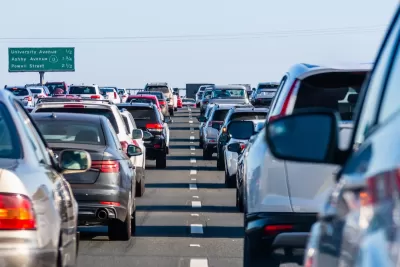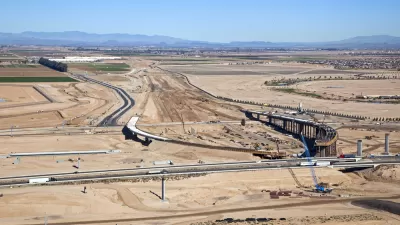The argument is being used to channel climate funding to projects that expand automobile infrastructure, according to an analysis from Transportation for America.

Federal funds aimed at reducing carbon emissions are being used for highway expansion projects, according to an analysis from Transportation for America. As Benton Graham explains in Bloomberg CityLab, the researchers used an AI model to identify projects that expand automotive infrastructure among roughly 60,000 projects nationwide.
The analysis found that a quarter of funds from the Infrastructure Investment and Jobs Act (IIJA)’s Carbon Reduction Program (CRA) are being used for road projects that, according to the organization, “stand to embed high transportation emissions for decades, incentivizing driving and encouraging ever-more-sprawled-out development and land use patterns.”
State agencies, which decide how funds are allocated, claim highway expansions can reduce emissions and air pollution by improving traffic flow and adding energy efficiency upgrades. “But experts point to decades of evidence showing that adding lanes is no fix for congestion, thanks to the well-documented principle of induced demand.” In Houston, peak hour travel times increased three years after a massive $2.8-billion freeway expansion.
“What does work? Policies that deincentivize driving — think stiffer tolls, congestion pricing and zone-based driving fees like London’s Ultra Low Emissions Zone, which charges drivers of high-polluting vehicles.”
FULL STORY: US Climate Funds Pay for Highway Expansion

Planetizen Federal Action Tracker
A weekly monitor of how Trump’s orders and actions are impacting planners and planning in America.

Congressman Proposes Bill to Rename DC Metro “Trump Train”
The Make Autorail Great Again Act would withhold federal funding to the system until the Washington Metropolitan Area Transit Authority (WMATA), rebrands as the Washington Metropolitan Authority for Greater Access (WMAGA).

The Simple Legislative Tool Transforming Vacant Downtowns
In California, Michigan and Georgia, an easy win is bringing dollars — and delight — back to city centers.

The States Losing Rural Delivery Rooms at an Alarming Pace
In some states, as few as 9% of rural hospitals still deliver babies. As a result, rising pre-term births, no adequate pre-term care and harrowing close calls are a growing reality.

The Small South Asian Republic Going all in on EVs
Thanks to one simple policy change less than five years ago, 65% of new cars in this Himalayan country are now electric.

DC Backpedals on Bike Lane Protection, Swaps Barriers for Paint
Citing aesthetic concerns, the city is removing the concrete barriers and flexposts that once separated Arizona Avenue cyclists from motor vehicles.
Urban Design for Planners 1: Software Tools
This six-course series explores essential urban design concepts using open source software and equips planners with the tools they need to participate fully in the urban design process.
Planning for Universal Design
Learn the tools for implementing Universal Design in planning regulations.
Smith Gee Studio
City of Charlotte
City of Camden Redevelopment Agency
City of Astoria
Transportation Research & Education Center (TREC) at Portland State University
US High Speed Rail Association
City of Camden Redevelopment Agency
Municipality of Princeton (NJ)





























